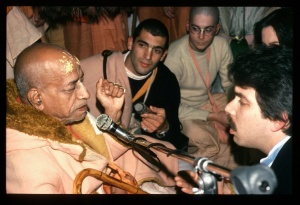CC Madhya 23.63: Difference between revisions
m (1 revision(s)) |
No edit summary |
||
| Line 1: | Line 1: | ||
{{ | [[Category:Sri Caitanya-caritamrta - Madhya-lila Chapter 23|C063]] | ||
<div style="float:left">'''[[Sri Caitanya-caritamrta|Śrī Caitanya-caritāmṛta]] - [[CC Madhya|Madhya-līlā]] - [[CC Madhya 23|Chapter 23: Life's Ultimate Goal — Love of Godhead]]'''</div> | |||
<div style="float:right">[[File:Go-previous.png|link=CC Madhya 23.62|Madhya-līlā 23.62]] '''[[CC Madhya 23.62|Madhya-līlā 23.62]] - [[CC Madhya 23.64|Madhya-līlā 23.64]]''' [[File:Go-next.png|link=CC Madhya 23.64|Madhya-līlā 23.64]]</div> | |||
{{CompareVersions|CC|Madhya 23.63|CC 1975|CC 1996}} | |||
{{RandomImage}} | |||
==== TEXT 63 ==== | ==== TEXT 63 ==== | ||
<div | <div class="verse"> | ||
:'vipralambha' catur-vidha—pūrva-rāga, māna | |||
pravāsākhya, āra prema-vaicittya-ākhyāna | :pravāsākhya, āra prema-vaicittya-ākhyāna | ||
</div> | </div> | ||
| Line 12: | Line 16: | ||
==== SYNONYMS ==== | ==== SYNONYMS ==== | ||
<div | <div class="synonyms"> | ||
''vipralambha''—separation; ''catur-vidha''—four divisions; ''pūrva-rāga''—''pūrva-rāga''; ''māna''—''māna''; ''pravāsa-ākhya''—known as ''pravāsa''; ''āra''—and; ''prema-vaicittya''—''prema-vaicittya''; ''ākhyāna''—calling. | |||
</div> | </div> | ||
==== TRANSLATION ==== | ==== TRANSLATION ==== | ||
<div | <div class="translation"> | ||
"Vipralambha has four divisions—pūrva-rāga, māna, pravāsa and prema-vaicittya. | |||
</div> | </div> | ||
| Line 26: | Line 29: | ||
==== PURPORT ==== | ==== PURPORT ==== | ||
<div | <div class="purport"> | ||
Pūrva-rāga is described in the Ujjvala-nīlamaṇi (Vipralambha-prakaraṇa 5): | ''Pūrva-rāga'' is described in the ''Ujjvala-nīlamaṇi'' (''Vipralambha-prakaraṇa'' 5): | ||
:''ratir yā saṅgamāt pūrvaṁ darśana-śravaṇādi-jā'' | |||
:''tayor unmīlati prājñaiḥ pūrva-rāgaḥ sa ucyate'' | |||
"When attachment produced in the lover and beloved before their meeting by seeing, hearing and so on becomes very palatable by the mixture of four ingredients, such as ''vibhāva'' and ''anubhāva'', this is called ''pūrva-rāga''." | |||
The word ''māna'' is also described in the ''Ujjvala-nīlamaṇi'' (''Vipralambha-prakaraṇa'' 68): | |||
: | :''dam-patyor bhāva ekatra sator apy anuraktayoḥ'' | ||
: | :''svābhīṣṭāśleṣa-vīkṣādi-nirodhī māna ucyate'' | ||
"''Māna'' is a word used to indicate the mood of the lover and the beloved experienced whether they are in one place or in different places. This mood obstructs their looking at each other and embracing each other, despite the fact that they are attached to each other.” | |||
''Pravāsa'' is also explained in the ''Ujjvala-nīlamaṇi'' (''Vipralambha-prakaraṇa'' 139), as follows: | |||
: | |||
:''pūrva-saṅgatayor yūnor bhaved deśāntarādibhiḥ'' | |||
:''vyavadhānaṁ tu yat prājñaiḥ sa pravāsa itīryate'' | |||
"''Pravāsa'' is a word used to indicate the separation of lovers who were previously intimately associated. This separation is due to their being in different places." | |||
Similarly, ''prema-vaicittya'' is also explained in the ''Ujjvala-nīlamaṇi'' (''Vipralambha-prakaraṇa'' 134): | |||
Similarly, prema-vaicittya is also explained in the Ujjvala-nīlamaṇi (Vipralambha-prakaraṇa 134): | |||
:priyasya sannikarṣe ‘pi premotkarṣa-svabhāvataḥ | :''priyasya sannikarṣe ‘pi premotkarṣa-svabhāvataḥ'' | ||
:yā viśeṣa-dhiyārtis tat prema-vaicittyam ucyate | :''yā viśeṣa-dhiyārtis tat prema-vaicittyam ucyate'' | ||
"''Prema-vaicittya'' is a word used to indicate an abundance of love that brings about grief from fear of separation, although the lover is present.” | |||
</div> | </div> | ||
__NOTOC__ | |||
<div style="float:right; clear:both;">[[File:Go-previous.png|link=CC Madhya 23.62|Madhya-līlā 23.62]] '''[[CC Madhya 23.62|Madhya-līlā 23.62]] - [[CC Madhya 23.64|Madhya-līlā 23.64]]''' [[File:Go-next.png|link=CC Madhya 23.64|Madhya-līlā 23.64]]</div> | |||
__NOTOC__ | |||
__NOEDITSECTION__ | |||
Revision as of 05:11, 13 September 2021

A.C. Bhaktivedanta Swami Prabhupada
TEXT 63
- 'vipralambha' catur-vidha—pūrva-rāga, māna
- pravāsākhya, āra prema-vaicittya-ākhyāna
SYNONYMS
vipralambha—separation; catur-vidha—four divisions; pūrva-rāga—pūrva-rāga; māna—māna; pravāsa-ākhya—known as pravāsa; āra—and; prema-vaicittya—prema-vaicittya; ākhyāna—calling.
TRANSLATION
"Vipralambha has four divisions—pūrva-rāga, māna, pravāsa and prema-vaicittya.
PURPORT
Pūrva-rāga is described in the Ujjvala-nīlamaṇi (Vipralambha-prakaraṇa 5):
- ratir yā saṅgamāt pūrvaṁ darśana-śravaṇādi-jā
- tayor unmīlati prājñaiḥ pūrva-rāgaḥ sa ucyate
"When attachment produced in the lover and beloved before their meeting by seeing, hearing and so on becomes very palatable by the mixture of four ingredients, such as vibhāva and anubhāva, this is called pūrva-rāga."
The word māna is also described in the Ujjvala-nīlamaṇi (Vipralambha-prakaraṇa 68):
- dam-patyor bhāva ekatra sator apy anuraktayoḥ
- svābhīṣṭāśleṣa-vīkṣādi-nirodhī māna ucyate
"Māna is a word used to indicate the mood of the lover and the beloved experienced whether they are in one place or in different places. This mood obstructs their looking at each other and embracing each other, despite the fact that they are attached to each other.”
Pravāsa is also explained in the Ujjvala-nīlamaṇi (Vipralambha-prakaraṇa 139), as follows:
- pūrva-saṅgatayor yūnor bhaved deśāntarādibhiḥ
- vyavadhānaṁ tu yat prājñaiḥ sa pravāsa itīryate
"Pravāsa is a word used to indicate the separation of lovers who were previously intimately associated. This separation is due to their being in different places."
Similarly, prema-vaicittya is also explained in the Ujjvala-nīlamaṇi (Vipralambha-prakaraṇa 134):
- priyasya sannikarṣe ‘pi premotkarṣa-svabhāvataḥ
- yā viśeṣa-dhiyārtis tat prema-vaicittyam ucyate
"Prema-vaicittya is a word used to indicate an abundance of love that brings about grief from fear of separation, although the lover is present.”